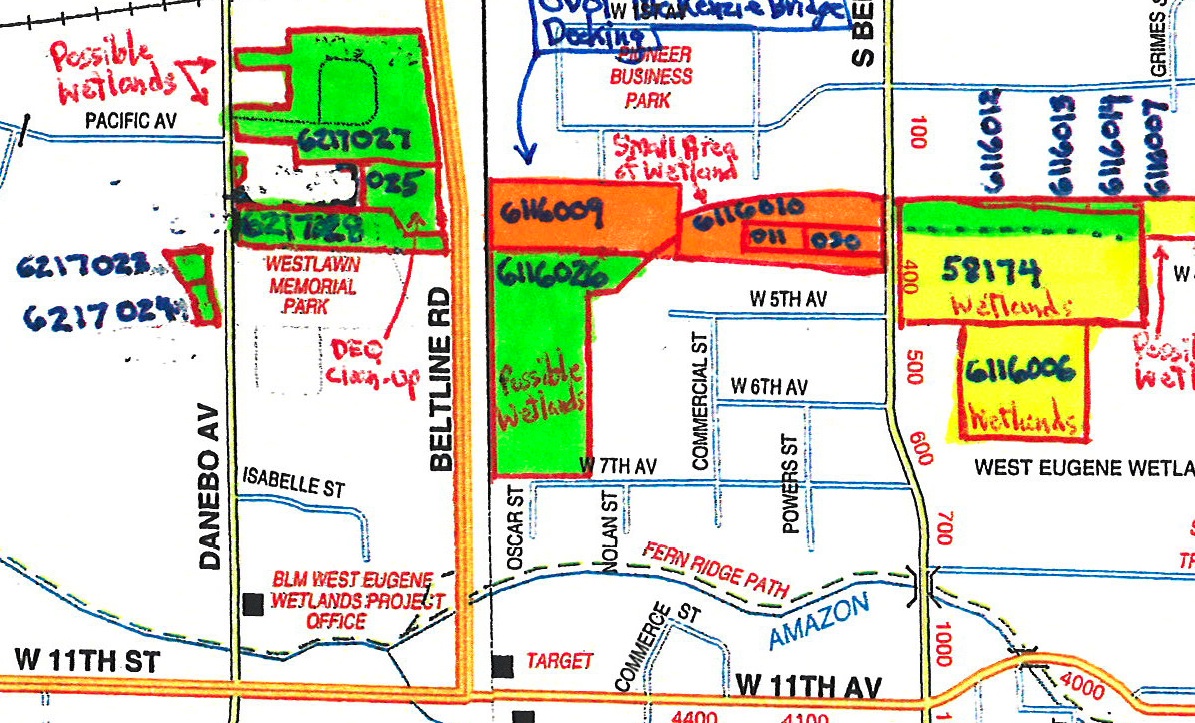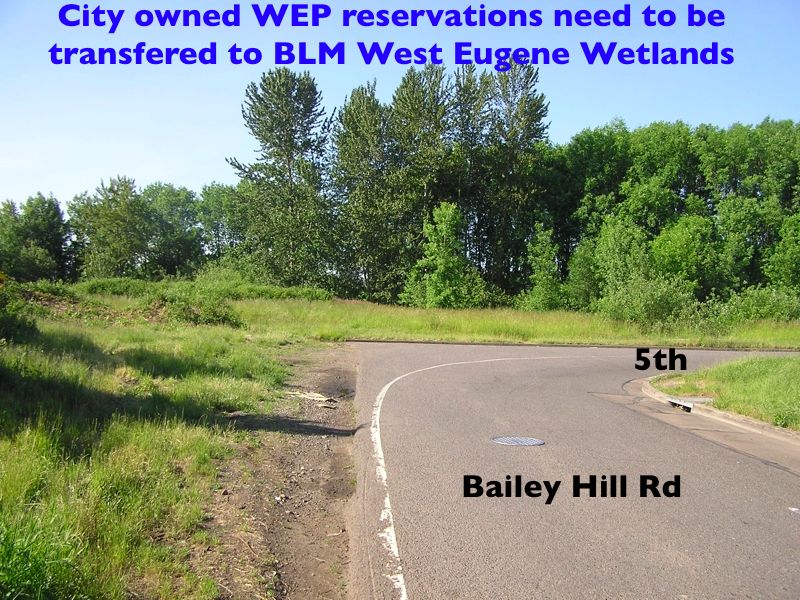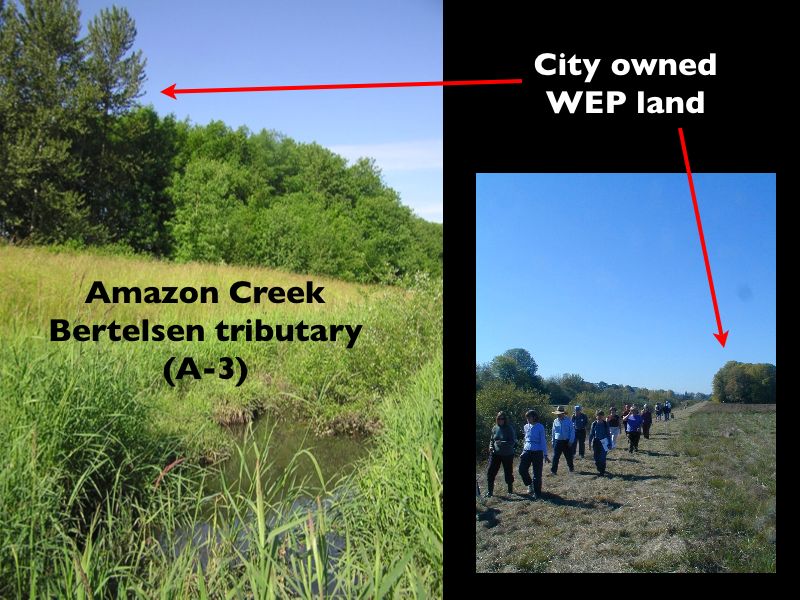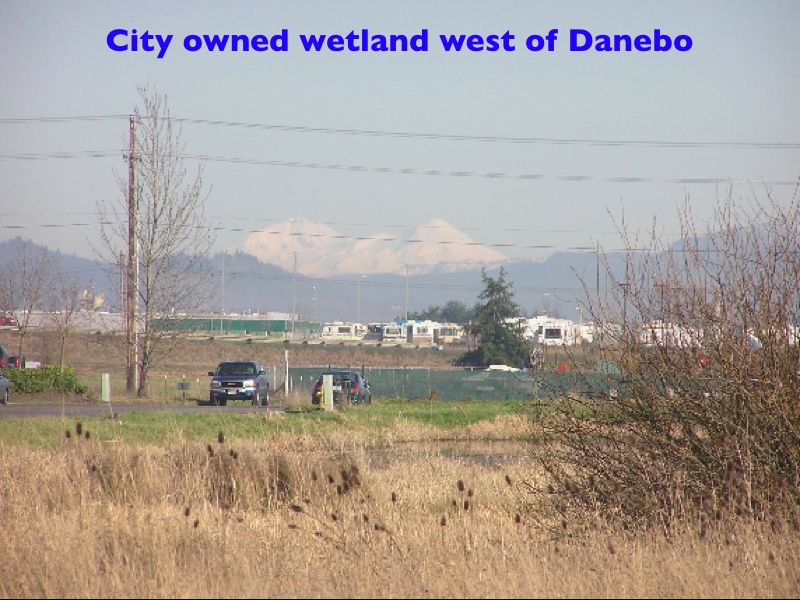Transfer WEP Land and Money
to drive a survey stake through the WEP
update 2020: ODOT sold several WEP reservation parcels to local developers. The City allowed new construction in several places, most notably at the Seneca / 5th intersection and west of Wallis Street (Jurassic storage).
1. ODOT transfers the $17.3 million already appropriated for the Parkway to other projects. Ideally, the money allocated for WEP should go to intersection work on West 11th, Beltline, Roosevelt and 99, and adding a shoulder (for safety) on 126 from Terry Street to Veneta.
2. The ODOT properties bought for the WEP are transfered to the Bureau of Land Management's West Eugene Wetlands conservation and restoration program.
Until these actions are completed, reports of the WEP's demise are premature.
update: The $17 million was transfered to other ODOT projects, but they were not projects to mitigate traffic flow in West Eugene. Some of the ODOT properties are being sold, see maps below.
Transfer ODOT properties to BLM for restoration
- ODOT Parcels
- west of Green Hill Road
- east of Green Hill Road (on both sides of the track, but only for a part of the route)
- WEP / Beltline interchange (northwest and southeast quadrants of interchange)
- Bertelsen Slough and wetland mitigation area at Bertelsen / Stewart Road intersection
- small area east of Wallis Street (behind closed hard disk factory)
City Parcels that also need to be added to the West Eugene Wetlands restoration efforts
- small area west of Danebo
- small area at WEP / Bailey Hill intersection
At the June 2001 West Eugene Charette, after ODOT representatives promised that they would implement “No Build” for the WEP, I asked several of them if this decision would include transferring the ODOT highway reservations to the BLM’s West Eugene Wetlands Park. They replied that this action had been discussed. It was reminiscent of Ronald Reagan’s advice to Mikhail Gorbachev when signing a disarmament treaty – “trust, but verify.” Verification that the promise of “No Build” had been implemented would be ODOT’s selling these reservations to their original owners and/or donating them to the Wetlands Park.
Several of these parcels would be unsuitable for what is euphemistically called “industrial and commercial development,” since they are swampy and completely surrounded by federal lands managed for wildlife preservation and low-impact recreation. Converting ODOT purchased land bought for the Parkway into parklands would further the State Planning Goals 5 and 8 - increasing protected habitat and facilitating recreation in and near urban areas. ODOT should consider land purchases for WEP to be a loss, especially since many of them were bought after the agency knew the Parkway was a long shot to be built (particularly the Spring 2002 purchase immediately west of Belt Line for the WEP / Belt Line interchange, which was made nearly a year after ODOT promised to select “No Build” for the Environmental Impact Statement).Most of the WEP lands have no “development” potential. Nearly all are seasonal wetlands that would be best added to the BLM restoration project (they currently function as de facto habitat protection, even if not officially designated as such). Several are surrounded by BLM parcels that have had major investments of money and people energy to restore native habitats - efforts that would be negated if these parcels are converted from their natural state.ODOT - if the “southern route” along the railroad tracks is no longer under consideration, ODOT should transfer its land south of the tracks and west of the Amazon bike pathBLM needs to be the caretaker of these lands so their experts can help remove non-native invasive species and help heal the land.
- ODOT lands to BLM west Eugene wetlands project
(Bertelsen Slough, Amazon Creek slivers, Green Hill Road wetland mitigation
site)
city land to BLM (especially next to Bertelsen Nature Park)
- explore feasibility of greenway from Bertelsen Nature Park to Willamette
Greenway - might be merely lots of street trees and a bike path weaving
under Chambers connector. Wildlife crossings?
bertelsen slough transfer - way to know it's really dead - create a park
- turn ODOT land to habitat restoration
rename “A-3” tributary of Amazon Creek to something less bureaucratic. If the indigenous name is not available, perhaps Bertelsen tributary of Amazon Creek
Whether the pro-WEP Oregon Transportation Commission is willing to do the sensible thing or not is a separate issue from what the technical people have determined.
ODOT's plans to sell part of the Parkway route - March 2008
Blue - sale pending
Green - declare surplus property (the Roosevelt / Beltline they're going to keep, probably for the possible interchange, the map is in error - the green for the interchange at WEP / BL also has lots of wetlands)
Yellow - possible critical habitat (note that the north side of Bertelsen Slough doesn't have this designation yet)
Orange - keep in ODOT property (looks like they're going to replace the old 126 bridge across the RR - the map says they're keeping it for future OTIA Bridge Project Replacement)





http://lcog.org/meetings/mpc/022006/MPC4.g.1.ii_Oregon_Interstate_Background.pdf
Interstate 50th Anniversary
The Story of Oregon’s Interstates
As might be expected, opposition to the re-routing of I-80N developed in the affected neighborhoods. In 1972, a complaint was filed in U.S. District Court seeking to halt the project pending additional corridor studies and filing of an Environmental Impact Statement. Following a similar pattern to that of the other proposed interstate projects during this period, opposition to the Mt. Hood Freeway continued on a variety of fronts, complicated by the then severe energy crisis that created acute gasoline shortages nationwide and pointed out the reliance of the U.S. transportation system on foreign oil supplies. On July 25, 1974, the Portland City Council withdrew its prior approval of the project by a vote of 4 to 1. A year later, in July 1975, the Mt. Hood Freeway was formally withdrawn and the funds reallocated. ...
Some of the funds that had been set aside for I-305 went toward widening a bridge across the Willamette River and toward the completion of the Salem Parkway, which joins I-5 at Keizer and connects to downtown Salem, following much of the route originally identified for I-305. The Salem Parkway was completed in 1986. ...
in early 1979, Governor Atiyeh petitioned the Federal Highway Administration for withdrawal of the I-505 Industrial Freeway from the system and the allocation of those funds for other transportation related projects in the area. In addition to funding traffic improvements in Northwest Portland, the Industrial Freeway withdrawal provided $15 million in funding for the Banfield Transitway Project, $7.4 million for the ODOT fund, and $21 million for improvements on SE 19th Avenue, SE Powell Boulevard, Oregon 217, the Sunset Highway, and Oregon 212. Other projects benefiting from this withdrawal included the Hollywood Business District, Holgate Bridge, the Willamette Greenway, and streetlight and transportation improvements for Swan Island and Columbia Boulevard (Oregon Journal, 15 December 1979).
Image from the year 2002:
The analogy for me is of a giant redwood I saw years ago in Humboldt
Redwood State Park.
In 1991, it was one of the largest ones in the bull creek ("Rockefeller
Grove") area. 17 feet across one way, and 7 feet across the other
way - the "Flatiron Tree."
It fell in a windstorm a few years later, and in 1998, when I saw it again,
it was lying on the forest floor. But it didn't know it was dead, and
it was sending out new shoots.
I saw it for the third time last fall, and it was finally dead.
The WEP has fallen down, but it doesn't know that it is really dead.
It's not dead until Bertelsen Slough is transferred from ODOT to the BLM,
and the money dedicated for the WEP is spent on the alternative road projects.